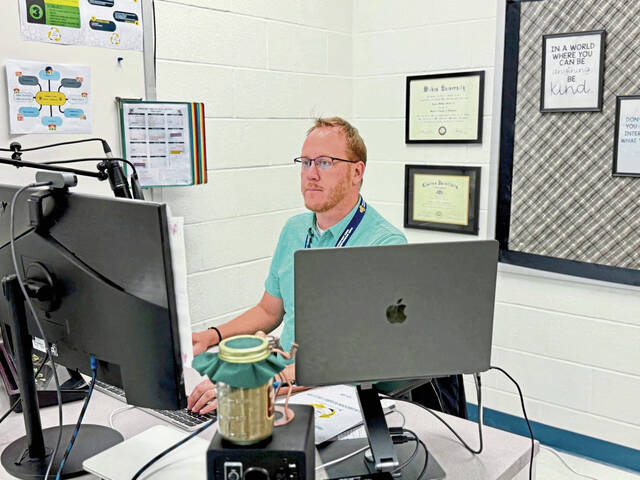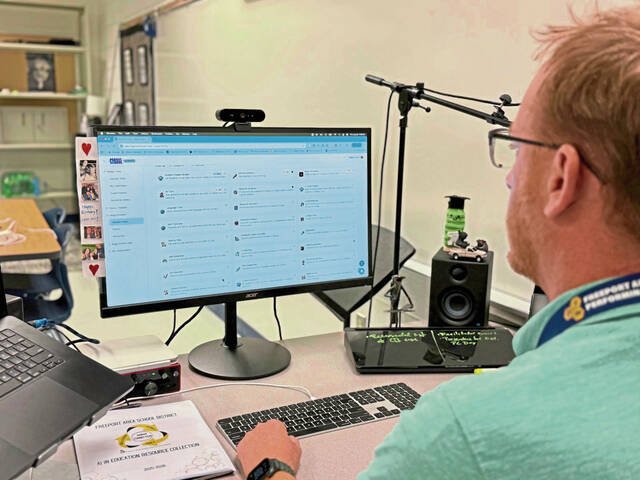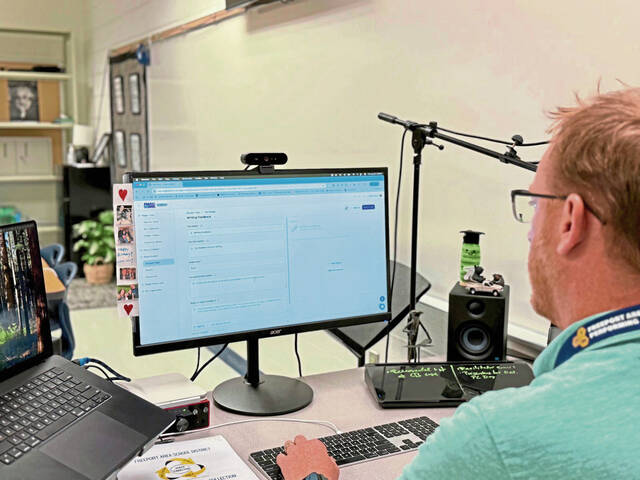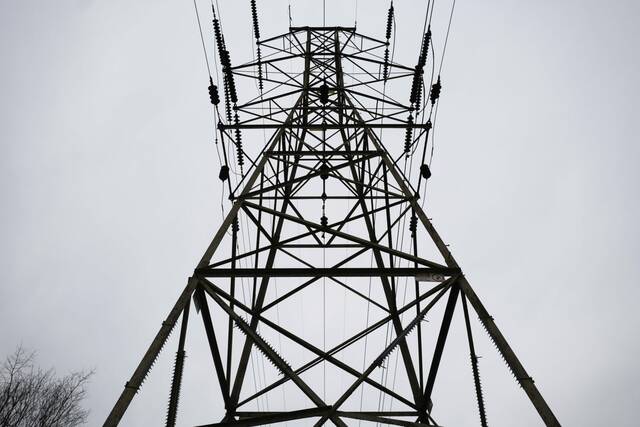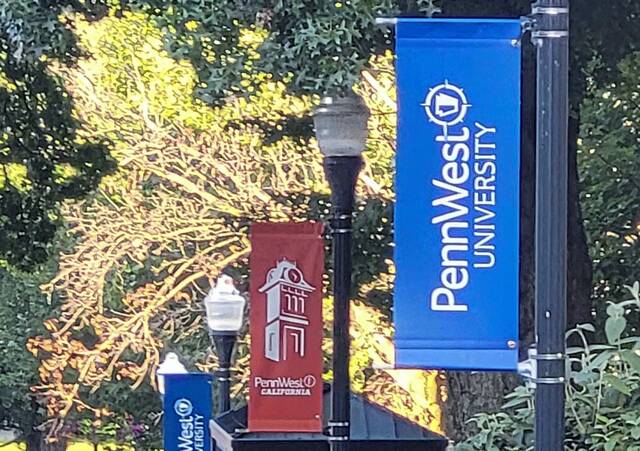When Emily Sanders worked as a high school English teacher, she never imagined being tasked with teaching her colleagues how to incorporate artificial intelligence into lesson plans.
“I learned how to teach Shakespeare to kids,” she said. “I didn’t learn how to teach technology to teachers.”
Fast forward and Sanders is deputy superintendent at Hempfield School District, helping her staff learn how to implement generative AI tools into their curriculum.
It’s just one example of the rush for school districts to prepare staff and students for the expected onslaught of AI technology.
“You have to get the teachers comfortable and understand how it works before you throw it at kids,” Sanders said. “We’re in the process of developing AI guidelines. We’re going to try to adopt some guidelines for teachers, students and parents to get the word out about what’s an acceptable use and what’s not.”
Anticipating the job market
Robert Harris, instructional technology coach for the Freeport Area School District, said the district began developing guidelines for AI use in 2022 after ChatGPT made its debut.
“We saw schools rush to block AI because everyone was worried about cheating. Freeport Area chose to take a very slow and methodical approach,” Harris said. “We thought from the very beginning we would be doing students a disservice to block AI and pretend it’s not there.”
AI already is making a significant impact in the workforce, and that’s only expected to accelerate:
• 60% of current jobs will require significant adaptation to AI, and the technology will fundamentally transform the global workforce by 2050, according to Forbes and groups such as the World Economic Forum.
• AI-skilled workers were paid an average of 56% higher wages in 2024 compared with non-AI workers, according to a June report from British multinational professional services network PwC. That doubled the premium workers were paid in 2023.
• The same report showed productivity nearly quadrupled in industries most exposed to AI since its rise in 2022. For example, financial services and software publishing saw an increase in productivity from 7% to 27% between 2018 and 2024. By comparison, the least AI-exposed industries, such as mining and hospitality, showed a 10% decrease in productivity over the same time.
• By 2030, up to 30% of hours worked on many activities could be automated through the use of AI, according to a 2023 report from the McKinsey Global Institute, a think tank connected to the global management consulting firm.
• A 2023 report from Goldman Sachs projected as many as 300 million jobs in the U.S. eventually could be affected by generative AI.
Teaching the teachers
Sanders has attained most of her knowledge about AI through networking. She has attended workshops and conferences, listened to educational podcasts and is subscribed to AI informational sources.
With no real technology background, she had to teach herself about AI so she could effectively train teachers.
“There’s not always formal training,” she said. “There’s not always a how-to guide.”
The best way to approach teaching AI is by having open communication with teachers, Sanders said.
“The more training you give them, the more support you give them, the more flexibility to try new things and fail and let them know as a boss that it’s OK,” she said. “If they have that space, they’re more apt to try things.”
Cassie Quigley, a professor of science education at the University of Pittsburgh, said communication is key when introducing AI to any environment.
“It’s new, you know, it’s so new for all of us and it’s changing so quickly,” Quigley said. “I think the more we open those avenues for communication instead of taking a punitive approach, we’ll really benefit everyone involved.”
Hempfield has about 25 new teachers this year, all of whom are required to complete an orientation program, Sanders said. As part of the program, the district is launching a Teach FX cohort.
Teach FX is an AI-powered tool designed for teachers that provides automated and private feedback on their classroom instruction by analyzing audio recordings. As part of their induction program, new teachers will be required to record a lesson plan and look at the recommendations from the program.
“It’s nice for teachers,” Sanders said. “It’s completely objective. It’s just going to give you the facts.”
Less than a year after the launch of ChatGPT, a committee composed of administration personnel and teachers was formed at Freeport Area to discuss how the district would approach AI in classrooms. Committee members decided students needed to learn what AI is before being taught how to use it.
Beginning this school year, Freeport Area introduced teachers to Magic School, an AI system that provides tools to adapt lesson plans based on grade level, subject matter, purpose of the assignment and other factors.
“It doesn’t replace us, but makes us better at our jobs,” Harris said.
Magic School and other AI tools like it are able to remove tedious tasks that arise during lesson creation, Harris said.
Using an example Harris provided, if an eighth grade social studies teacher creates a lesson plan and reading assignment but has students in class at different reading levels, Magic School is able to automatically adjust the assignment to meet those reading levels. Harris said this would give the teacher more time to interact with students.
“By embracing AI in an effective and ethical way, we’re able to create the opportunity for more human connection,” Harris said.
The nearly 400 teachers at Hempfield are being introduced to the “traffic light” strategy as a way to keep students and teachers on the same page for assignments, Sanders said.
“The thought of that is red light means no AI, a green light is go ahead and use AI,” Sanders said. “A yellow light would be (students) can use AI, but only for certain parts of an assignment or they should discuss with their teachers first.”
Trainings also cover how to teach students about ethical AI use and how to check the validity of sources that larger language models provide to students, Sanders said.
Training can look different depending on the materials discussed, Sanders said. During some in-service days, Sanders trains the district’s almost 30 administrators on what’s being taught that day. Those administrators would then carry out the same lesson, with teachers being split into groups of 20 to 30 for each administrator.
Teachers are given the opportunity to practice the skills and ask questions throughout the lesson.
Sanders said administration has received overall positive feedback about the integration of AI.
“They actually had requested more AI training,” she said. “It’s on the upswing. I still think there are people that you have to win over because I think a lot of people are skeptical.”
Teachers have been given the green light to try AI in classrooms if they’re comfortable with the technology, Sanders said. Some teachers have been using subscriptions to AI tools as a pilot program of sorts.
The introduction of AI into mainstream technology has been reminiscent for some of other major tech developments.
“I remember when the internet came out,” Sanders said. “I remember everybody being fearful of it and skeptical. … That’s kind of the same thing now that you’re seeing, especially from some older folks that have been around for a while. I think it will shift just like it did with the internet.”
Quigley compared skepticism about AI to the public opinion when graphing calculators were introduced.
“We learned the importance of teaching students how to use a graphing calculator,” Quigley said. “I think if we use that analogy here for AI, it’s also important for when to introduce it.”
AI with students
Starting in third grade, Freeport teachers will begin to introduce AI to students, Harris said. They won’t necessarily be using it, but students will be taught what AI is and how to use it ethically.
Once students reach upper grades, students will be able to begin using AI.
In middle school, students will take a class called digital literacy, which dives further into the ethics of using emerging technology such as AI, Harris said.
There can be various applications for students to use AI.
Quigley, the Pitt professor, suggested it could assist as a writing tool as students develop their writing skills.
“It can be useful early on as a spellchecker or prompt generation,” she said.
At Freeport, maybe AI serves as a study tool, Harris said.
For example, high school students will be learning about the American Revolution in history this year, he said. The teacher can assign students to a class and direct them to interview a prominent figure from the war.
“Kids can prompt the (AI) chat to embody a historic figure,” Harris said. “The students can write questions in the chat, and it will respond as if they’re speaking with that person.”
Teachers have access to the chat and can monitor conversations between the students and AI.
At the college level, Quigley has seen her students use AI in numerous ways. Some students upload a study guide and then have the AI program quiz them.
“It’s sort of like the modern-day flashcards,” Quigley said.
AI can be useful when a student is stuck on an assignment and needs to brainstorm, she said. Some AI programs allow students to upload reading sources and turn them into a podcast so students can explore materials from a different perspective.
Quigley stressed students can become overly reliant on AI if it is not used correctly, leading the technology to replace some learning.
“I think there’s a con as well in terms of bias and misinformation,” Quigley said.
She has found young people want to be part of the conversation surrounding AI and how to set boundaries for its use in the classroom.
She said students can be hesitant about using AI for an assignment when their work will be run through an AI checker, where it could be flagged. Teachers who use AI detection tools can deter students from using the technology altogether, Quigley said.
She suggested leaving a comment box available for students so they can disclose AI usage and explain why when submitting assignments. This opens a line of communication where students can learn when AI is appropriate and teachers can see where students are struggling.
“Involve your student population in these conversations and creating the policies around AI because they actually have a lot to say about it,” Quigley said.
One thing seems certain, Quigley said. AI could be the new norm for classrooms and other everyday functions.
“I think there is a lot of longevity. I think it’s smart for schools to include AI curriculum just like they included typing and word processing and data science,” Quigley said. “I think there’s a lot of teeth to this.”



